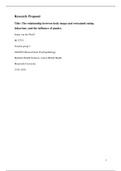Research Proposal
Title: The relationship between body image and restrained eating
behaviour, and the influence of gender.
Sanne van der Werff
I6132751
Tutorial group 3
GGZ2023 Research Into Psychopathology
Bachelor Health Sciences, course Mental Health
Maastricht University
15-01-2019
1
, Background and introduction
Dissatisfaction with the body is seen as an important factor that plays a role in the development
of eating disorders (Furnham, Badmin, & Sneade, 2002; Polivy & Herman, 2002; Stice, 2002).
Body image (operationalized as body appreciation) is an important determinant of eating
behaviour. Wrong eating behaviour can be divided into three eating styles: emotional eating,
external eating and dietary restraint. This can be measured by the Dutch Eating Behaviour
Questionnaire (Van Strien, Frijters, Bergers, & Defares, 1986). Anyone can experience negative
emotions, but in some people negative emotions can lead to (too many) food. Food interferes
with the real function of food; ensure that people can respond optimally to the environment
(Evers, Marijn Stok, & de Ridder, 2010). Emotion eating is found in relatively healthy women
as well as in women with eating disorders (Spoor, Bekker, Van Strien, & van Heck, 2007). By
the time that too much is eating, negative emotions as debt can emerge. In addition to
psychological consequences, this can also have health risks (Spoor et al., 2007). In addition to
emotion eaters, external eaters also exist. External eaters do not have the natural reaction to stop
eating when saturation occurs. External eaters are extra sensitive to external cues and do not
respond to internal cues. Feelings of hunger and satiety are interpreted in the wrong way (van
Strien, 2007). Besides emotion eaters and external eaters, there are also restrained eaters.
Restrained eating means reducing food intake to control body weight (Stunkard & Wadden,
1990). Restrained eaters are often chronic dieters and people with a normal body weight
(Polivy, Herman, Younger, & Erskine, 1979). Dieting seems to result in psychological
manifestations such as distractibility and in eating binges once food is available (Polivy, 1996).
Body image has been conceptualized as a complex and multi-faceted construct
embracing many aspects of how people experience their own embodiment, especially their
physical appearance (Cash, 2012). Body satisfaction means that an individual is happy and
satisfied with their own body. People often want to lose weight to look more attractive.
Especially women are not satisfied with their own body (Kelly, Wall, Eisenberg, Story, &
Neumark-Sztainer, 2005). A negative body image can lead to the development of difficulties in
eating behaviour (Attie & Brooks-Gunn, 1989); more diets, unhealthy behaviour to control
weight, eating too much, less physical activity and less fruit and vegetable consumption.
Women tend to demonstrate more body dissatisfaction than men do. They also report higher
levels of weight control, health and mood motives for eating and a higher restrained eating style
(Conner, Johnson, & Grogan, 2004). The nature of body weight dissatisfaction is, however,
slightly different in men and women. Women are more likely to judge themselves overweight
2





